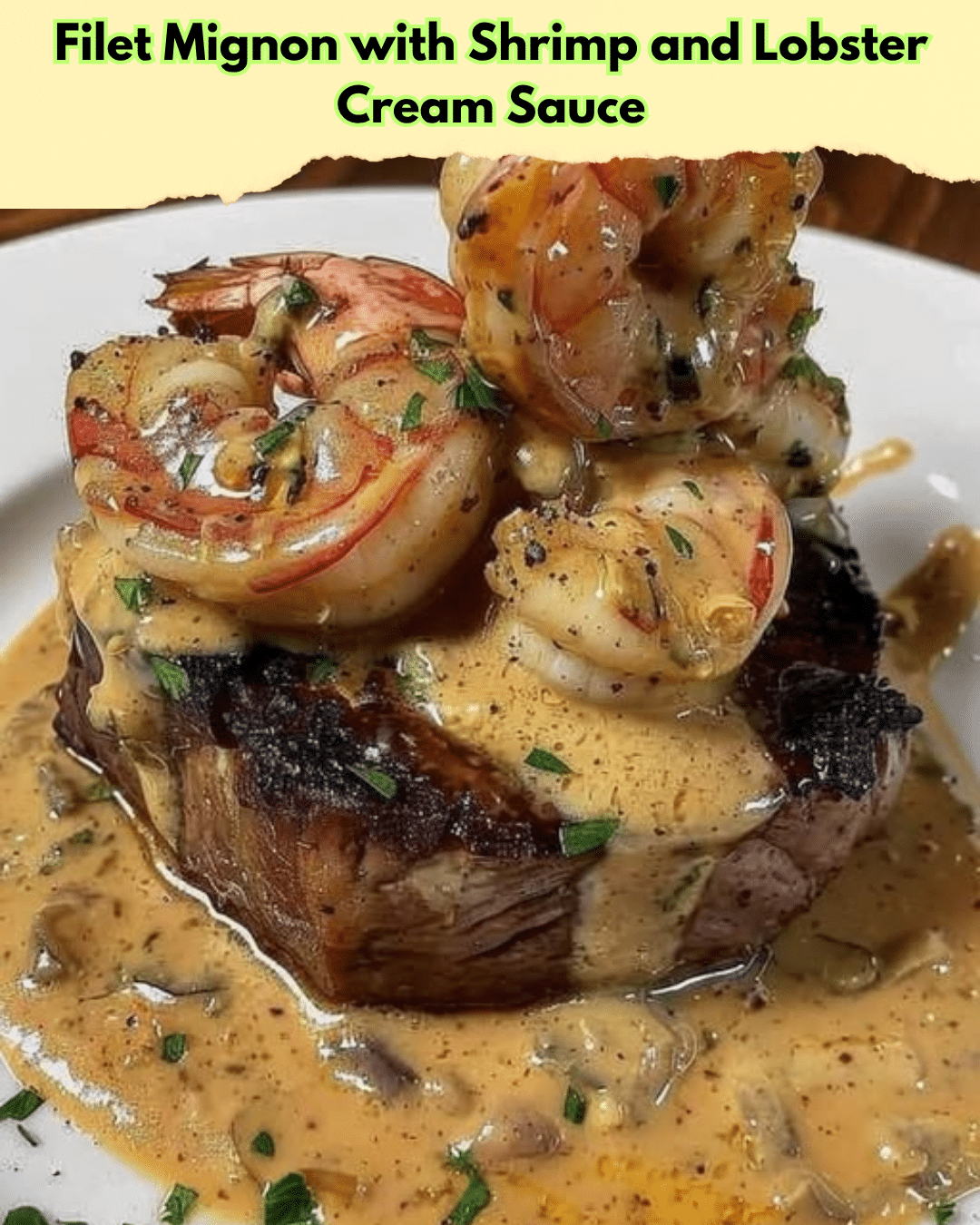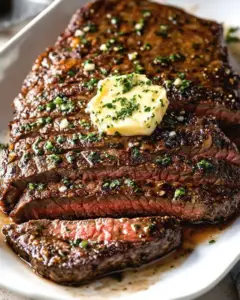Filet Mignon with Shrimp and Lobster Cream Sauce: A Gourmet Delight
Indulge in the luxurious flavors of our Filet Mignon with Shrimp and Lobster Cream Sauce. This exquisite dish combines the tender, juicy filet mignon with succulent shrimp, all draped in a rich, decadent lobster cream sauce. Perfect for a special occasion or a romantic dinner, this recipe promises a memorable dining experience. The harmony of surf and turf on one plate offers not only an unforgettable taste but also a symphony of textures and aromas that delight the senses.
In the first bite of this Filet Mignon with Shrimp and Lobster Cream Sauce, you are met with intense satisfaction from the meat’s velvety texture, combined with the delicate sweetness of the crustaceans. As you explore further, the complex layers of flavor from the lobster-infused sauce marry beautifully with the natural flavors of the beef, creating a sophisticated and exquisite taste adventure that captivates the palate.
Quick Recipe Highlights
- Flavor Profile: The filet mignon offers a rich, beefy flavor that’s perfectly enhanced by the buttery lobster cream sauce, with shrimp adding a slight briny sweetness.
- Texture: Enjoy the melt-in-your-mouth tenderness of the filet, complemented by the firm, juicy shrimp and the velvety smoothness of the cream sauce.
- Aroma: The robust aroma of seared beef and the delicate scent of seafood create an intoxicating atmosphere.
- Visual Appeal: A beautifully seared filet topped with golden-brown shrimp and smothered in a creamy, pale gold sauce garnished with fresh herbs.
- Skill Level Needed: Intermediate skills are required to properly sear the beef and create a smooth emulsion in the sauce.
- Special Equipment: A heavy-duty skillet or cast-iron pan and a whisk are essential for achieving the perfect sear and sauce consistency.
Recipe Overview
- Difficulty Level: With some experience in pan-searing and sauce-making, this recipe becomes a manageable challenge that rewards with impressive results.
- Category: A main course that bridges the gap between surf and turf, offering the best of both worlds in one meal.
- Cuisine: This dish takes inspiration from classic French cuisine, where complex sauces and quality cuts of meat are celebrated.
- Cost: The filet and seafood may carry a premium price, but the exquisite dining experience it creates is well worth the investment for special occasions.
- Season: Ideal for fall and winter when rich, hearty meals are most appreciated, though it can be enjoyed year-round.
- Occasion: Perfect for anniversaries, holidays, or any celebration where an extraordinary dish is desired.
Why You’ll Love This Recipe
Prepare to be amazed by the taste and texture appeal of filet mignon paired with a luxurious lobster cream sauce. The richness of the beef effortlessly harmonizes with the seafood’s sweet and savory tones, offering a flavor experience akin to dining at a high-end restaurant. The distinct notes of fresh herbs and a touch of citrus brighten the palate, leaving you thoroughly satisfied.
Convenience is key, as this seemingly complex dish can be assembled in less than an hour. With just a few quality ingredients and simple steps, you can bring an elegant restaurant-quality meal to your home table. The instructions provide clear guidance to ensure stunning results every time.
Nutritional advantages abound with this protein-rich dish, offering not only a high-quality protein source from the filet, shrimp, and lobster but also essential amino acids, vitamins, and minerals. Pairing it with vegetables or a light salad balances the meal.
The social and entertaining value is unbeatable, perfect for impressing guests or loved ones. The presentation and flavors make it an ideal centerpiece for any dining event, leaving a lasting impression while fostering conversation.
From a cost-effectiveness and accessibility standpoint, while the dish uses premium ingredients, each component can be sourced from supermarkets, making it feasible for home cooks. By preparing it at home, you gain a significant advantage over restaurant prices while retaining quality and control over portions.
Historical Background and Cultural Significance
The filet mignon, French for ‘dainty fillet,’ has roots deeply embedded in French culinary tradition. Revered for its tenderness and relatively mild flavor, it became an icon of luxury dining and remains a staple in gourmet kitchens worldwide. Its enduring popularity is due in part to its versatility and its ability to pair wonderfully with various sauces and sides.
Lobster cream sauce originated in French haute cuisine, where sauces were often used to elevate the natural flavors of dishes while showcasing the chef’s skill. As seafood became more accessible, combining lobster and cream became a celebrated accompaniment for refined dishes, enhancing dining experiences with its rich, velvety texture.
The evolution of this recipe took shape as surf and turf concepts gained traction in American dining, merging land and sea elements. This created an exciting venue for culinary creativity, pushing chefs to craft exciting combinations that highlight the best of each component.
Regional variations in preparing filet mignon with shrimp and lobster cream sauce might include incorporating locally available seafood or using different herbs to complement the main ingredients. In coastal areas, fresh-caught crustaceans might replace store-bought options for heightened freshness, showcasing regional diversity.
Ingredient Deep Dive
Each main ingredient in this recipe provides a unique contribution to the overall dish, both culturally and nutritionally. The filet mignon represents the pinnacle of beef cuts, thanks to its tenderness and fine muscle grain. Selecting a well-marbled piece ensures rich flavors when cooked correctly, with the deep umami notes enhanced by a proper sear.
When it comes to shrimp, its quick cooking time and ability to absorb surrounding flavors make it a sweet companion to hearty dishes. Fresh shrimp provide essential omega-3 fatty acids, bringing additional health benefits to the table. Substitutions like scallops can offer a similar texture and sweetness if needed.
The preparation of lobster cream sauce dates back to the French culinary tradition of utilizing every part of an ingredient, with lobster stock forming the base. To store, keep it chilled in sealed containers and reheat slowly to preserve its lush texture. If lobster isn’t available, a seafood stock or even crab can provide a comparable taste.
Common Mistakes to Avoid
- Under-seasoning the filet can lead to a bland taste; ample seasoning creates a crust that enhances flavor.
- Overcooking shrimp results in rubbery bites; aim for a firm but tender texture.
- Rushing the sauce-making process can result in a broken emulsion; whisk patiently until the desired texture is achieved.
- Failing to rest the meat before serving allows juices to escape, diminishing the dish’s succulence.
- Using unsalted butter for the sauce might alter the flavor balance; adjust seasoning accordingly.
- Ignoring ingredient quality compromises the entire dish; opt for high-quality beef and seafood whenever possible.
- Improperly heating the cream for the sauce might cause it to curdle; low and slow is key.
- Omitting fresh herbs detracts from the visual and aromatic appeal; garnish generously.
Essential Techniques
Mastering essential techniques ensures success when creating this sophisticated dish. The sear is of primary importance, as it forms a flavorful crust on the filet mignon. A hot, well-oiled pan will create a Maillard reaction, enriching the beef’s taste complexity and enhancing its overall palate appeal.
Making the lobster cream sauce requires gentle heat and patience to form a stable emulsion. Employ a whisk continuously when combining the cream and lobster to encourage a velvety, cohesive sauce. Avoid letting the sauce boil to prevent separation, and use visual cues like sheen and thickness to identify readiness.
Proper temperature management ensures that all components are served at their peak flavor and texture. Searing and timing are crucial; prepare components simultaneously to avoid delays and temperature drops before plating. The harmony of hot filet, warmed sauce, and fresh shrimp completes the dish.
Pro Tips for Perfect Filet Mignon with Shrimp and Lobster Cream Sauce
Choose dry-aged beef for more concentrated flavors, offering a deeper umami complexity that stands up to the richness of the lobster cream. Allow the steak to come to room temperature before cooking for a consistent sear.
To enhance the lobster cream sauce, toast off lobster shells in the pan before adding cream, infusing the sauce with robust lobster essence.
Timing is critical when preparing the shrimp; add them to the pan only during the last few minutes of cooking to maintain their delicate texture.
Use a thermometer to monitor the filet mignon’s internal temperature, targeting a precise medium-rare for the best texture and flavor.
Balance the dish’s richness with a squeeze of lemon juice to bring a refreshing quality and sharpen the flavors.
For a sophisticated twist, consider infusing the butter with fresh herbs like tarragon or chives before making the sauce to layer in aromatic complexity.
Variations and Adaptations
Regional variations make this dish adaptable to local tastes and preferences. In Mediterranean regions, incorporate olives and sundried tomatoes for a sun-kissed flair, while East Asian adaptations might introduce ginger or soy to the sauce.
Seasonal adaptations capitalize on freshest ingredients, such as spring asparagus or autumn squash, adding complementary textures and flavors to the dish. Summer allows for fresh herbs like basil to shine, enhancing the plate’s aromatic profile.
Dietary modifications provide inclusivity, especially for gluten-free or keto-friendly options, by adjusting sauce thickeners or eliminating starch-based components.
Flavor variations can involve smoked salts or spiced rubs on the filet for an entirely different flavor profile that speaks to personal taste preferences, tailored to suit the dining experience.
Texture modifications may include sous-vide preparation for the filet, offering unparalleled tenderness and moisture retention, creating a luxurious bite with each forkful.
Presentation alternatives focus on deconstructed plating, where components are artfully arranged to invite diners through a visual journey, amplifying the dish’s aesthetic intrigue.
Serving and Presentation Guide
Achieving elegance in plating elevates the dish to its full potential. Utilize a wide, flat plate to allow the distinct components room to shine, making use of negative space as a visual frame. A center filet topped with shrimp and cascading lobster sauce ensures focal unity and mouthwatering presentation.
Garnishing ideas add color and freshness, such as a sprinkle of microgreens or a dusting of finely chopped parsley, imparting vibrant greenery against the suite of browns, golds, and reds.
Traditional accompaniments like buttery mash or asparagus provide grounding balance, with creamy textures and bright flavors complementing the rich protein ensemble.
Modern serving suggestions explore small plates or tapas-style offerings, ideal for tastings or pairing with a diverse menu. Whether served as a personal portion or shared among guests, this approach adds a layer of sophistication.
Temperature considerations ensure every bite is enjoyed at its premium. Prepare each component in succession, timing plating to ensure warmth without interfering with textures.
Portion control tips tackle maintaining the dish’s indulgence while respecting dietary needs. Serving moderate slices of filet keeps the dish from feeling overindulgent, letting shrimp and sauce accents accentuate without overshadowing.
Wine and Beverage Pairing
Wine pairings that heighten the rich flavors of Filet Mignon with Shrimp and Lobster Cream Sauce include a full-bodied red wine like Cabernet Sauvignon or a lush Chardonnay with subtle oaky notes, complementing the beef and sauce’s depth.
Non-alcoholic alternatives like sparkling water with a splash of lemon or a white grape juice mimicking acidity in wine offer freshness and contrast to the dish’s rich essence.
Coffee or tea pairings aren’t traditionally considered, but a gentle green tea might refresh the palate after a savory meal, preventing lingering richness from becoming overwhelming.
Temperature considerations maintain the upscale experience, particularly with wine served slightly below room temperature to accentuate its flavors without competing with the dishes.
Serving suggestions for accompanying beverages tend towards elegant stemware, which visually signifies the sophistication of each pairing, while enhancing aromas and displaying color to its advantage.
Storage and Shelf Life
Storing leftovers involves airtight containers to maintain quality, ensuring the filet and shrimp remain tender. Refrigeration within two hours of cooking safeguards against flavor degradation and safety.
Temperature requirements see optimal storage below 40°F in the fridge, extending the dish’s shelf life for up to three days. Avoid freezer storage as texture may suffer upon thawing.
Container recommendations embrace shallow glass or BPA-free airtight containers, preventing odor transfer and preserving moisture without condensation issues.
Signs of spoilage include off-smells or discoloration, which indicate a need to discard components for safety and to maintain food quality.
Reheating instructions favor gentle microwave warming at reduced power, with frequent stirring to uphold sauce consistency. Reheating on a stovetop over low heat ensures the filet remains tender.
Freezing guidelines suggest isolating the sauce and solid elements if needed, with a defrost in the fridge leading to a gradual, even reheating —without direct heat causing separation or texture decline.
Make Ahead Strategies
A thoughtful prep timeline underscores effective make-ahead strategies: prepare the lobster cream sauce a day in advance and refrigerate, allowing flavors to meld and thicken overnight.
Storage between steps sees storage containers maintaining freshness, with components such as prepared filet being seared just before serving for peak texture.
Quality impact assessment reveals no adverse influence when executed correctly, preserving flavor integrity while enhancing meal preparation convenience.
Assembly tips suggest sequencing ingredients just before dinner for seamless gastronomic delivery, allowing a natural ebb and flow from kitchen to table.
Reheating guidelines stress minimal temperature settings to recreate the plated experience while retaining the dish’s luxurious mouthfeel.
Fresh element additions like quick-sautéed shrimp at the last moment, ensure vibrant texture and color, completing the plate’s culinary narrative.
Scaling Instructions
Adapting scaling instructions addresses how to retain quality: halving sees ingredient measures precisely reduced, maintaining balance across dish elements, including sauce seasoning.
Doubling or tripling the recipe necessarily involves reevaluated pan sizes, ensuring even cooking without crowding, while ingredient availability may prompt utilizing multiple cooking locations.
Equipment adjustments might require multiple skillets or larger saucepans to maintain consistent quality and cooking conditions, ensuring proportional heat distribution.
Timing modifications consider enhanced cooking times dictated by increased quantities, maintaining awareness of finished dish integrity through careful observation.
Storage considerations surge prominently with larger batches, warranting precise staging pre- and post-cooking, maintaining spatial and temperature balance for optimal storage efficiency.
Nutritional Deep Dive
The nutritional breakdown of this entrée showcases a balanced ensemble featuring high protein from the filet, shrimp, and lobster, aiding muscular repair and growth.
Micronutrient analysis acknowledges seafood’s provision of zinc and B-vitamins, vital to numerous bodily functions, in addition to iron from the beef, supporting blood health.
Health benefits further unfold with sea-derived omega-3 fatty acids, demonstrating cardiac support and anti-inflammatory properties embedded within the dish.
Dietary considerations pivot around ensuring portion sizes and accompaniments align with health goals, noting the rich composition of the sauce as an indulgent aspect.
Portion analysis accounts for limiting each component to maintain a lean yet satisfying meal that fits caloric and nutritional boundaries, without compromising culinary excellence.
Weight management tips see lighter side dishes accompanying the protein and sauce, curbing calorie overconsumption through green vegetables or citrus salads.
Dietary Adaptations
Gluten-free adaptations might utilize cornflour or arrowroot to thicken sauces rather than standard flour-based methods, preserving tenets of flavor while ensuring suitability.
Dairy-free alternatives include substituting coconut cream or almond milk for the lobster cream sauce, maintaining richness while catering to lactose-adverse or vegan palates.
A vegan version may explore tofu or plant-based fillet options combined with a vegetable stock-based cream sauce derived from roasted garlic and nuts for texture and flavor.
Low-carb adaptations suggest zucchini noodles or cauliflower rice, paralleling traditional starch options with modern keto-friendly replacements for mindful dining fulfillment.
Keto enthusiasts can celebrate this dish’s innate compatibility with a focus on protein-rich components, requiring minor modifications like increased butter use for cream sauce integrity.
Paleo adherents may gravitate toward unprocessed, wholesome choices by maintaining the primary meats and enhancing use of fresh herbs and vegetables.
Low-FODMAP adjustments involve selecting low-garlic and onion options for sauce creation while preserving the core of the recipe’s flavors and protein focuses.
Troubleshooting Guide
Troubleshooting for texture issues involves revisiting cooking temperatures and times across proteins; ensuring a proper sear at high heat leaves each component tender.
Flavor balance concerns may stem from seasoning inadequacies; a technique counteracting this through mindful salt and herb adjustments enhances profile satisfaction.
Temperature problems due to overdone proteins or underheated sauces can be rectified by reheating low-temp and short-burst exposure, ensuring cohesiveness post-mishap.
Equipment challenges often link to overcrowding; utilizing extra pans for the filet sear reduces dripping, ensuring a uniform crust crucial for taste.
Ingredient substitutions require sensitivity searches through flavor parallels, achieving comparable taste profiles with different elements like poultry in place of beef.
Timing concerns incite corrective structuring of workflow sequences, particularly ensuring components reach optimal readiness synchronously for plating impressiveness.
Recipe Success Stories
Communicating community feedback reveals positive embracement, encouraging culinary adventure and family cohesion through shared cooking experiences.
Variation successes emerge where seasonal ingredients enhance traditional versions, inspiring enhanced recipes from nature’s ever-changing cycles.
Adaptation stories showcase accessible creativity where dietary needs prompt explorative substitutions, allowing health-conscious versions without taste compromise.
Reader suggestions provide helpful tips regarding presentation, including herb accents or spiral-cut vegetables, imparting dish vibrancy and stimulation.
Photography tips underline the importance of lighting; spotlighting highlights condiment colors and textures, inviting both visual and gustatory indulgence.
Frequently Asked Questions
Can I substitute shrimp with another seafood? Scallops or crab work well, delivering sweet marine notes that pair harmoniously with the lobster cream sauce.
How to prevent my lobster cream sauce from separating? Ensure emulsion by gradually adding cream while whisking continuously, maintaining a gentle heat without boiling.
What wine works best with filet and seafood together? Choose a full-bodied red like Cabernet Sauvignon or a bright white like Pinot Gris to complement both meat and sauce richness.
How long can leftovers be stored? Refrigerate promptly within two hours, maintaining flavor and quality three days ideally, circumventing freezer degradation risks.
Can I prepare sauce a day ahead? Yes, advance preparation melds flavors effectively; reheat gently to preserve sauce integrity when plating.
What’s an effective herb garnish? Fresh parsley introduces refreshment and color contrast, enhancing the filet’s visual and aromatic appeal.
Should filet be marinated beforehand? The filet doesn’t require marination due to its inherent flavor robustness but might benefit from a quick herb and olive oil rub pre-cooking.
What alternatives exist for a dairy-free version? Coconut cream offers an excellent substitute, maintaining the luxuriant texture without dairy emphasis.
Why is filet mignon often chosen over other cuts? Its unparalleled tenderness and mild flavor resilience render it a preferred cut, spotlighting where top ingredients and culinary skill converge.
Can I serve the sauce over other proteins? Yes, it’s a versatile accompaniment, pairing beautifully with chicken or firm fish like halibut.
Additional Resources
Dive deeper into culinary excellence with our related recipes, featuring indulgent classic pairings such as Beef Wellington or Lobster Bisque, which continue the tradition of flavorful opulence.
Technique guides empower mastery over foundational skills like pan-searing and sauce emulsification, ensuring mastery over, and perfect execution of, significant culinary milestones.
Ingredient information highlights shelf-life considerations, sustainable sourcing, and quality choices, fostering educated decisions around dish components.
Equipment recommendations assess culinary tools ensuring precision, including temperature probes, cast iron pans, and immersion blenders for comprehensive dish delivery.
Seasonal variations explore how ingredients like heirloom tomatoes or spring peas invigorate the main recipe through nature-led enhancements, continuously inspiring cooks.
Print
Filet Mignon with Shrimp and Lobster Cream Sauce
Description
A luxurious surf and turf dish featuring juicy filet mignon, succulent shrimp, and a rich lobster cream sauce.
Ingredients
For the Crust:
- 2 filet mignon steaks
- 8 large shrimp, peeled and deveined
- 1 cup lobster meat, cooked
- 1 cup heavy cream
- 2 tablespoons white wine
- Salt and pepper to taste
- 2 tablespoons butter
- 1 tablespoon olive oil
- 1 garlic clove, minced
- 1 tablespoon fresh parsley, chopped
Instructions
1. Prepare the Crust:
- Season the filet mignon steaks with salt and pepper.
- Heat olive oil and 1 tablespoon of butter in a pan over medium-high heat. Add the steaks and cook to desired doneness. Remove and let rest.
- In the same pan, add remaining butter and minced garlic. Sauté the shrimp until pink and cooked through, then remove and set aside.
- Deglaze the pan with white wine, then add heavy cream and lobster meat. Simmer until sauce thickens.
- Return shrimp to the pan and heat through.
- Serve filet mignon topped with shrimp and lobster cream sauce. Garnish with freshly chopped parsley.
Notes
You can customize the seasonings to taste.




